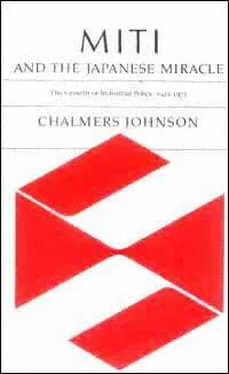Chalmers Johnson - MITI and the Japanese miracle
Здесь есть возможность читать онлайн «Chalmers Johnson - MITI and the Japanese miracle» весь текст электронной книги совершенно бесплатно (целиком полную версию без сокращений). В некоторых случаях можно слушать аудио, скачать через торрент в формате fb2 и присутствует краткое содержание. Год выпуска: 2007, Издательство: Stanford University Press, Жанр: Старинная литература, на английском языке. Описание произведения, (предисловие) а так же отзывы посетителей доступны на портале библиотеки ЛибКат.
- Название:MITI and the Japanese miracle
- Автор:
- Издательство:Stanford University Press
- Жанр:
- Год:2007
- ISBN:нет данных
- Рейтинг книги:3 / 5. Голосов: 1
-
Избранное:Добавить в избранное
- Отзывы:
-
Ваша оценка:
- 60
- 1
- 2
- 3
- 4
- 5
MITI and the Japanese miracle: краткое содержание, описание и аннотация
Предлагаем к чтению аннотацию, описание, краткое содержание или предисловие (зависит от того, что написал сам автор книги «MITI and the Japanese miracle»). Если вы не нашли необходимую информацию о книге — напишите в комментариях, мы постараемся отыскать её.
MITI and the Japanese miracle — читать онлайн бесплатно полную книгу (весь текст) целиком
Ниже представлен текст книги, разбитый по страницам. Система сохранения места последней прочитанной страницы, позволяет с удобством читать онлайн бесплатно книгу «MITI and the Japanese miracle», без необходимости каждый раз заново искать на чём Вы остановились. Поставьте закладку, и сможете в любой момент перейти на страницу, на которой закончили чтение.
Интервал:
Закладка:
This trend toward genuine public-private cooperation grew out of a combination of the effects of war destruction and the reforms of the occupation. The old zaibatsu were weakened vis-à-vis the state-control bureaucrats by the physical depletion of their capital assets and by the occupation's goal of deconcentrating the economy. At the same time the new constitution and other reforms such as the fostering of the labor movement made state control politically impossible except as a short-term expedient. The economic bureaucrats might rule on the basis of their intrinsic talents, but they could never reign openly under Japan's new democratic system. Thus, both government and industry recognized the need for a political division of laborone that would both advance the positive development program and forestall disruptions of it by the newly enfranchised groups in the society.
The resulting Japanese political system of the 1950's and 1960's bore some resemblance to the ''corporatism" that Charles Maier believes emerged in interwar continental Europe. He writes:


The key to consensus or mere civic peace was either forcible suppression or constant brokerage. Any major organized interest could disrupt a modern economy or imperil social order, hence had to be silenced by duress or granted a minimum of demands. The need for brokerage switched the fulcrum of decision making from the legislature as such to the ministries or new bureaucracies. During the war, ministries of munitions had developed into economic planning agencies. . . . They coopted private business in this task, sharing public powers to increase the scope of regulation. Although wartime controls were not retained, the 1920s did not simply revert to the degree of market freedom prevailing before 1914. . . . A defining characteristic of the corporatist system . . . was the blurring of the distinction between political and economic power. Clout in the market placeespecially the potential to paralyze an industrial economymade for political influence. Consequently, economic bargaining became too crucial to be left to the private market, and state agencies stepped in as active mediators.
66
Page 197
The causes of post-World War II Japanese-style "corporatism" were similar, but its priorities were different, and the state played a role that went beyond mediation. The Japanese well understood the potential in their situation for disruption and civil strife as new groups in the society tested and adapted the Allied-installed democratic system. It is astonishing how easily foreign admirers of the tranquility of Japanese society during the 1970's forget the strikes, riots, demonstrations, and sabotage that marked the period 194961. But more important than the need to mediate among the demands of interest groups was the need, recognized by all Japanese, to escape from the economic misery and dependence on foreign assistance that the events of the 1940's had produced. Capital was in short supply, the new technology needed was to be found only overseas, costs were too high, the country imported more than it sold abroad, and the ability to compete internationally was as yet only a dream. Under these circumstances, the role of the state was never questioned. In circumstances quite different from either the 1930's or the 1940's, the economic general staff, enjoying more power than under self-control but less than under state control, was finally given a chance to try to make Japan a wealthy nation.
Page 198
Six
The Institutions of High-Speed Growth
No one observing the Japanese economy from the vantage point of Dodge's "stabilization panic" of 194950 could have imagined either the high-speed growth that was to occur between 1955 and 1961 or the "golden sixties" that lay beyond. The years of the Dodge Line and the Korean War were characterized by constant confusion, high hopes alternating with deep despair, political and bureaucratic contention among numerous power centers, and governmental expediency in the face of one crisis after another. The Japanese had to adjust successively to the virtual strangulation of their economy under Dodge's draconian antiinflation measures, to the Korean War boom, to fundamental changes in United States foreign policy, to the deep postKorean War recession, and to the discovery of their own balance-of-payments business cycle. They also had to come to terms with the institutions the occupation had left behind and with the attitudes of their own bureaucrats and industrialists toward these institutions.
During the period 1949 to 1954 the Japanese forged the institutions of their high-growth system. In 1954, with the passing of the Yoshida government and other political developments, MITI put the system into effect. To understand the Japanese economic performance of the late 1950's, it is necessary to appreciate that when all the various institutions of the Korean War era were put together and operated by an "economic general staff," they constituted a systemalthough no single institution was ever created with the emerging system in mind. As Nakamura Takafusa has argued, the agencies of 195561 for forcing investment from a poor, capital-starved society resulted from the combination of two complicated sets of circumstancesthe persis-
Page 199
tence of wartime and occupation controls until very late in the postwar era, and the tremendous strengthening of competition that was an unintended consequence of the emergency measures for industrial financing adopted by the government during the "stabilization panic."
1
Some of the elements of what became MITI's high-growth system derived from the government's selection of industries for "nurturing," perfection of measures to commercialize the products of these chosen industries, and development of means for regulating the cut-throat competition that the first two sets of policies generated. The tools in the hands of the economic bureaucrats included control over all foreign exchange and imports of technology, which gave them the power to choose industries for development; the ability to dispense preferential financing, tax breaks, and protection from foreign competition, which gave them the power to lower the costs of the chosen industries; and the authority to order the creation of cartels and bank-based industrial conglomerates (a new and rationalized version of the zaibatsu, now made totally dependent on government largesse), which gave them the power to supervise competition. This high-growth system was one of the most rational and productive industrial policies ever devised by any government, but its essential rationality was not perceived until after it had already started producing results unprecedented for Japan or any other industrialized economy.
The system began to be forged during the Dodge Line. Dodge's policies certainly ended inflation, but at the cost of almost shattering what little economic recovery had been achieved through priority production. The cutting off of government price subsidies and loans to industry from the Reconstruction Finance Bank (RFB) eliminated the main sources of capital in the system, and there simply were no alternative sources to fill the void, either from the internal savings of enterprises or from the new capital market that SCAP was trying to foster. Equally important, when governmental aid to designated sectors of priority production stopped and SCAP began to promote export industries, there was a radical reallocation of what little private capital was available. Funds for coal and electric power development declined drastically, while funds for the reestablished textile industry shot up.
2
SCAP was pleased by this development, since textiles earned foreign exchange, but Japanese bureaucrats saw an energy crisis looming. And even the policy of export promotion was seriously undermined by the devaluation on September 18, 1949, of the British pound. The pound was cut by 30.5 percent in terms of U.S. dollars, its value dropping from $4.03 to $2.80, a step that caused some 30 other
Читать дальшеИнтервал:
Закладка:
Похожие книги на «MITI and the Japanese miracle»
Представляем Вашему вниманию похожие книги на «MITI and the Japanese miracle» списком для выбора. Мы отобрали схожую по названию и смыслу литературу в надежде предоставить читателям больше вариантов отыскать новые, интересные, ещё непрочитанные произведения.
Обсуждение, отзывы о книге «MITI and the Japanese miracle» и просто собственные мнения читателей. Оставьте ваши комментарии, напишите, что Вы думаете о произведении, его смысле или главных героях. Укажите что конкретно понравилось, а что нет, и почему Вы так считаете.












